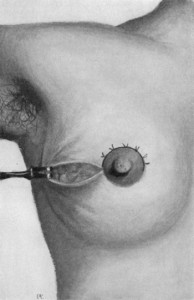Cosmetic reshaping of the female breast is a collection of well known procedures such as implants and various forms of lifting and reduction. These breast procedures are so well accepted that it seems they have been around forever. But this is largely a cultural perception as what we know today or grew up with always seems like it has always been so.

‘Is cosmetic correction of the female breast deformed in some manner indicated even if no grave reasons propose it, if only the desire of thewoman or girl exists? As we are already been used to performing corrections of other regions of the body upon desire of the patient for a considerable period of time, we should not make an exception if mammaplasty is concerned, although we have to admit that the correction of the female breast, regardless if we deal with ptosis or hypertrophy of the breast, is always a major surgical procedure, which should be reserved for the hand of the experienced surgeon. We correct a hallux valgus of only moderate degree without reservation even if it causes no complaints but represents only a minimal malformation of the foot of its owner. We move protruding ears operatively closer to the head to satisfy a long standing desire of their bearer, who imagines appearing ridiculous because of his ears. We remove supernumerary digits of the hand of a child if desired by the parents as well as a vascular or pigmented nevus of the cheek; we correct the saddle nose or humps and all other deformities of this organ to protect its bearer from being conspicuous and free him from often only imagined ridicule; the overhanging panniculus is removed operatively; bents in legs not impairing ambulation in any way but regarded as unaesthetic experience surgical correction. We could add further to this examples of correcting deformities of the human body only because of patient desires. We also should not overlook that the wish to correct even a minimal malformation of a body part may, if constantly rejected, eventually result in depressive symptoms and maybe even in a feeling of physical inferiority. The refusal to alleviate a fault in the body’s appearance can therefore under very special circumstances result in the end in pathologic processes, which have to be taken seriously and necessitate treatment by a psychiatrist.Based on these considerations and taking into account the consequences alluded to, which could result, we will neither discount a priori the justification of the desire to have breast correction nor reject a well founded wish. The already large number of successful mammaplasties proves that surgeons have been acting along the above lines for a couple of years and additional testimony is provided in particular by respected authors such as Lexer, Kraske, Holländer, Axhausen and others preoccupying themselves with operative breast corrections and describing new operative methods or improvements of existing ones verbally and pictorially. Eiselsberg expressed this attitude regarding breast correction as well in 1928 when he performed such an operation as a demonstration for foreign guests giving the following introductory statement:
If I had been approached ten years ago to operate on a
ptotic breast for merely cosmetic reasons I would have
refused. You see, we have gone with the times, have
changed our point of view to take into account the wishes
of the public but without undiscerningly and uninhibitedly
accommodating arbitrary desire.
As can be seen from these very flowery but passionate writings from Dr. Beisenberger way back in 1930, reshaping a breast has an important psychological effect on a woman’s body image. It is not a recent phennomenon that has been merely promoted by contemporary fashion and beauty standards. The issue today is not whether it is morally appropriate for a plastic surgeon to perform a breast lift but whether the patients can accept the scars to do so.
Dr. Barry Eppley
Indianapolis, Indiana


